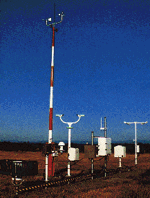Automatic weather stations
| B. Geerts and E. Linacre | 7/'98 |
| Manned weather stations are expensive to operate because of the labour costs, so they are being gradually replaced by automatic weather stations (AWS), at least in the developed countries. In Australia, for instance, 16 AWSs were installed on islands off the north and west coasts in the late 1960ís, and the network was enlarged during the 1980ís, with over 150 AWS (of Australian manufacture) by 1994 and about 250 by 1998. In the USA, Automated Surface Observing Systems (ASOS) currently have been installed at 972 locations, mostly airports and pre-existing (manned) weather stations. Advantages of AWSs include lower labour cost, mainly in remote areas, and more frequent observations (possibly every minute). Calibration and maintenance are still required, but reduced-maintenance systems are being developed. Many AWS stations use solar power. The data are transmitted to the large networks either via telephone dial-in or, in remote areas, via satellite. As such, automatic stations are now the primary surface-weather-observing network in many regions. |
Traditionally, AWSs only measured air temperature, wind speed and direction, and air pressure. A tipping bucket raingauge was added next. The wet-bulb technique is not feasible to measure atmospheric humidity, because it requires a clean wick and a supply of distilled water. One humidity technique used on AWSs involves a laser beam. This beam is reflected on a mirror, which is chilled to the dewpoint. The resulting droplets on the mirror scatter the laser beam, and this event signals that the dewpoint has been reached.
Other variables measured on at least some modern AWSs are:
- sky condition: cloud height and amount (clear, scattered, broken, overcast) up to 3,500 m;
- visibility (to at least 15 km), as well as fog or haze;
- type of precipitation;
- wind gustiness;
- sunshine duration, and possibly other radiances (visible, infrared ...).
In the estimation of cloudiness, there is an important difference between human and AWS observations: a person takes a look at the entire sky at the measurement time, whereas an AWS continuously looks up (to the zenith) and integrates over time to estimate cloudiness. Different biases result. Cloudiness at middle and high levels cannot be measured by means of AWSs.
